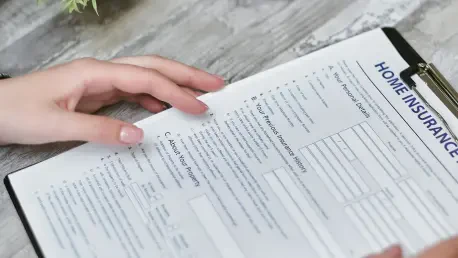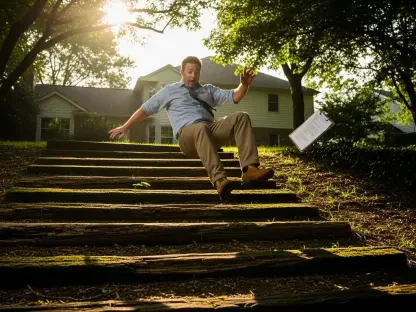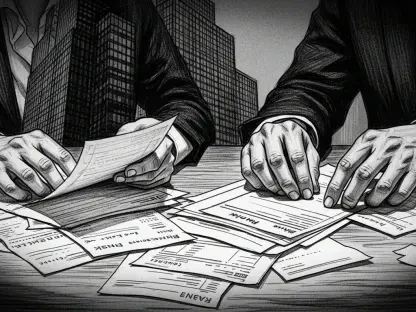In the heart of Florida, homeowners are caught in a relentless struggle against a property insurance crisis that shows no signs of abating, with premiums soaring to unprecedented heights and coverage options shrinking by the day. This dire situation, fueled by the state’s unique exposure to natural disasters, has left countless families financially strained and deeply frustrated. While the anger over escalating costs and inadequate protection is palpable and justified, it alone cannot mend the broken system. Emotional reactions, though a natural response to such hardship, fall short of addressing the deep-rooted issues plaguing the insurance market. Instead, a shift toward actionable, systemic solutions is essential to bring stability and relief to those burdened by this ongoing predicament. This discussion delves into the core challenges facing Florida’s homeowners, from immense coastal risks to flawed financial strategies, and underscores the urgent need for reforms that go beyond mere outrage to create a resilient and equitable insurance landscape.
Unpacking the Coastal Risk Burden
Florida stands as the epicenter of hurricane-related risk in the United States, with over $3 trillion in insured coastal property hanging in the balance. Each storm season brings the looming threat of catastrophic losses, often tallying into tens or even hundreds of billions of dollars, an amount no insurance market can fully shoulder without imposing substantial premiums. Disregarding this stark reality has led to a dangerous cycle of artificially suppressed rates, which in turn causes insurer insolvencies and forces taxpayers to foot the bill for bailouts. This approach not only fails to mitigate the underlying vulnerability but also exacerbates the financial strain on the state’s residents. The sheer scale of exposure, driven by Florida’s geography and extensive coastal development, demands a reckoning with the true cost of living in such a high-risk area, pushing for policies that reflect this reality rather than sidestepping it for short-term relief.
Moreover, the continuous expansion into storm-prone regions aggravates the already staggering risk profile. Without stringent controls on development, the potential for astronomical losses grows with every new structure built in vulnerable zones. Past efforts to curb premiums through regulation have often ignored the fundamental issue of exposure, leading to a fragile market that buckles under the weight of inevitable disasters. The insurance system must adapt to prioritize resilience over temporary affordability, ensuring that rates align with the actual dangers faced by coastal communities. This shift, though challenging, is critical to prevent the recurring collapse of insurers and the subsequent burden on public funds. Addressing this immense risk requires a candid acknowledgment of Florida’s unique position and a commitment to building a market capable of withstanding the inevitable storms that define life in the Sunshine State.
Behavioral Patterns Fueling Underinsurance
A significant yet often overlooked factor in Florida’s insurance crisis lies in the decision-making tendencies of homeowners themselves. Many, swayed by a desire to save money in the short term or an unfounded belief that disaster will spare them, opt for minimal coverage, resulting in a staggering 78% of Floridians being underinsured. This choice, while seemingly rational at the moment, leaves families woefully unprepared when hurricanes strike, often leading to financial ruin as the costs of rebuilding far exceed their limited policies. Such behavioral patterns not only jeopardize individual households but also destabilize the broader insurance market by creating a widespread gap between risk and protection. Addressing this issue calls for strategies that counteract these tendencies and encourage more comprehensive coverage decisions.
Beyond personal choices, these patterns are deeply rooted in psychological biases that skew perceptions of risk. Homeowners frequently prioritize immediate savings over long-term security, underestimating the likelihood of a major storm impacting their property. This mindset, coupled with a reluctance to change existing inadequate plans, perpetuates a cycle of vulnerability that ripples through communities after each disaster. Educational initiatives and policy incentives could play a pivotal role in shifting these attitudes, helping residents understand the true stakes of underinsurance. By fostering a culture of preparedness rather than denial, the state can reduce the collective burden of uninsured losses and build a more stable foundation for its insurance system. Tackling this behavioral challenge is as crucial as any structural reform in ensuring that Florida’s homeowners are equipped to face the inevitable challenges of their environment.
The Perils of Post-Disaster Borrowing
Florida’s current approach to managing catastrophe costs through post-disaster borrowing presents a troubling and unsustainable financial strategy. Institutions like the Florida Hurricane Catastrophe Fund often resort to issuing billions in bonds after major storms to cover claims, effectively deferring today’s expenses to future generations. This practice, while providing immediate relief, balloons long-term costs for families and delays a necessary confrontation with the state’s inherent risk profile. The reliance on debt rather than proactive funding mechanisms creates a fragile system that grows increasingly unstable with each passing storm season. A fundamental shift away from this reactive model is imperative to safeguard the financial health of both residents and the insurance market as a whole.
Additionally, the absence of preemptive financial reserves amplifies the crisis by failing to account for predictable disaster cycles. Building up funds during calmer years could significantly lessen the need for costly borrowing, yet the state continues to lean on a system that burdens future budgets. This shortsightedness not only increases economic strain but also erodes public trust in the mechanisms meant to protect homeowners. Transitioning to a model of pre-disaster funding would require tough decisions and upfront investments, but the payoff in reduced debt and enhanced stability would be substantial. Policymakers must prioritize such forward-thinking strategies to break the cycle of perpetual financial catch-up, ensuring that Florida’s insurance framework is built on a foundation of preparedness rather than reaction. This change is vital to creating a sustainable path forward.
Why Frustration Falls Short
The mounting frustration among Florida homeowners is both evident and warranted, as premiums continue to climb while coverage options dwindle, leaving many paying more for less protection. Transparency about the stability of insurers remains elusive, further fueling distrust in a system that seems stacked against the average resident. Public discourse often amplifies this discontent, capturing the raw emotion of families stretched thin by unrelenting costs. However, while this anger serves as a powerful signal of the crisis’s severity, it lacks the capacity to drive meaningful change on its own. Emotional responses, though a natural outlet, risk overshadowing the need for focused, constructive solutions that address the systemic flaws at the heart of the problem. A pivot from venting to actionable reform is essential to move the needle.
Furthermore, allowing outrage to dominate the conversation can stall progress by diverting attention from the root causes to surface-level grievances. The complexity of Florida’s insurance challenges—ranging from immense risk exposure to flawed financial practices—requires a response grounded in analysis rather than emotion. Historical patterns show that public frustration, while loud, often fades without catalyzing the structural shifts needed for lasting improvement. Redirecting this energy toward advocating for specific, principle-based reforms offers a more promising avenue for relief. Homeowners and policymakers alike must channel this discontent into a unified push for changes that tackle the underlying issues, ensuring that the momentum of public sentiment translates into tangible outcomes rather than dissipating into unresolved complaints. This shift in focus is crucial for breaking the deadlock.
Building a Resilient Insurance Future
To confront Florida’s insurance crisis head-on, a series of practical, principle-based reforms must take center stage over temporary fixes or emotional outcries. Implementing stronger building codes and curbing unchecked development in high-risk coastal areas can significantly reduce exposure to catastrophic losses. Additionally, making home mitigation measures—such as installing hurricane shutters or reinforcing roofs—more affordable through installment plans rather than hefty upfront costs could boost adoption rates, especially among lower-income households. These steps, though not glamorous, lay the groundwork for a market that prioritizes resilience over short-term affordability, aligning costs with the true risks of living in a storm-prone state. Such reforms demand commitment but promise a more stable future for all stakeholders.
Equally important is the push for pre-disaster funding and transparency within the insurance sector. Accumulating reserves in the Florida Hurricane Catastrophe Fund during quieter years would lessen the reliance on post-storm borrowing, easing the long-term financial burden on families. Simultaneously, disclosing which insurers fail annual catastrophe stress tests is non-negotiable—homeowners deserve clarity on whether their claims will be honored in a crisis. These measures, combined with incentives for comprehensive coverage, can rebuild trust and create a system that honestly prices risk while fostering preparedness. Reflecting on past shortcomings, it’s evident that reactive policies have only deepened the struggle. Moving forward, the focus must be on proactive solutions that empower residents and policymakers to anticipate challenges, ensuring that Florida’s insurance landscape emerges stronger from lessons learned.









